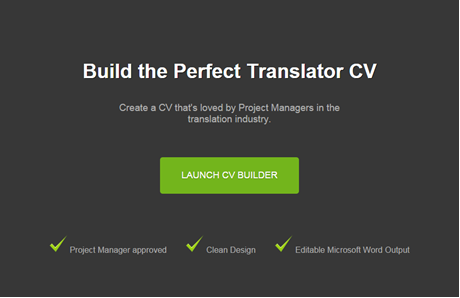
Not surprisingly, most freelance translators have two jobs: translating content and finding clients. While many have (hopefully) honed the former skill, the latter still remains a challenge for many linguists. When working with direct clients, pitches that demonstrate expertise and a unique value proposition are often preferred to sending the client your resume or portfolio. But, when you’re working with agencies, your CV is the first point of contact and having a well-structured, concise and well-written CV can often mean the difference between getting the work and being rejected.
Thousands of hopeful linguists send CVs to agencies every day but unfortunately, many of these are pretty poor. Admittedly, there is no single best way of writing a great CV, but there are a lot of ways to get it wrong. While there are quite a few articles online on writing translator CVs, many of them provide vague and sometimes contradictory information.
So where can budding linguists find the advice they need? Are there any tools out there that can help? Well, we found that there weren’t any interactive tools out there to help translators structure their resumes – so we decided to build one.
Enter the not-so-imaginatively-named TRANSLATOR CV BUILDER.
THE TRANSLATOR CV BUILDER
 As you can guess from the slightly hyperbolic title of this post, the idea behind this free tool is to guide translators, beginners and intermediate alike, to create a CV that follows best practices and contains the information most translation agencies look for.
As you can guess from the slightly hyperbolic title of this post, the idea behind this free tool is to guide translators, beginners and intermediate alike, to create a CV that follows best practices and contains the information most translation agencies look for.
In order to do this, the tool presents structured forms that force you to enter only the essential information and prompt you to keep it short, focused and fluff-free. After being guided on a step-by-step basis, you can send the end result directly to prospective agencies or use it as a blueprint or inspiration to create your own, more personalised version.
HOW TO USE IT
The Translator CV Builder is divided into four main sections.
SECTION 1
Personal details
This section is pretty standard – you will be asked to insert your contact details; in fact, you will be forced to do so. After all, how useful would a CV without a phone number or email address be?
You will notice that the only geographical information that’s required is the City/Country. The reasoning behind this is that realistically the agency won’t need to know your street address, but it is important for them to establish if you live in the country of your target language (not always a necessity) and which time-zone you are in.
What? No picture? That’s right. Translators should be chosen on merit and agencies care more about experience and skills than looks. It just happens that everyone at TranslateMedia is extremely good looking. Although it’s nice to put a face to a name, that usually comes later once the right candidates are selected.
Services
Your language pair is presented at the top since this is the first piece of information that a project manager will look at. There is only one target language because reputable agencies will only allow you to translate into your native language. If you happen to be a fully bilingual translator, you may wish to amend that in the final document. You will also have the option to tick additional services that you provide such as voiceover or interpreting. These are all keywords that will be searched for in the database when that particular service is required, so make sure you fill these in.
SECTION 2
Education – Here you can insert your qualification and the schools/universities you attended. Without selling yourself short, try not to go all the way back to high school, if the courses you completed are not relevant.
You can (should) also add any professional courses you’ve undertaken. This is good because it shows agencies that you are interested in continuous professional development in order to maintain and refine your skills. When listing courses, make sure they are also relevant. This doesn’t mean that you should only include translation courses: for example, if you provide transcreation or marketing translation services, listing a professional marketing course or qualification could be advantageous and help you get noticed.
SECTION 3
Experience
There are several ways to showcase your experience as a freelance translator. For convenience, it has been divided into sectors, so that project managers can easily identify suitable linguists for each project. The number of (obviously approximated) words that you have translated is not a requirement (and yes, applicants sometimes make these up) but it gives an idea of your experience in each field. Remember to include the types of projects you have worked on and, if you are permitted, some notable clients you’ve worked with.
References
Again not a necessity, however keep in mind that even if you don’t specify them in your CV, most agencies will (should) ask you at a later stage, before starting a working relationship with you.
SECTION 4
Tools
This should be pretty self explanatory. If you use any CAT tools, be sure to list them here. You can also add other tools, such as any word processing or graphic design software that you regularly use to aid you in your work. Now you are ready to download you CV!
This template is a good compromise between the more creative and standard templates. This is by no means the best or only layout you should use, but it is easily legible, and well structured – two good signs of an effective CV.
The output is a Microsoft Word document (if you use a Mac, remember it will look much better in Word than in Pages or Open Office) so that you can modify and personalise it as you see fit. Once you’re ready, you can make your final edits and simply select “Save as” in the file menu and choose PDF to create a professional looking, non-editable document to send to prospective agencies.
Please note that the tool is currently in beta, so feel free to provide feedback, bearing in mind we will be adding more templates and functionality in the future. Should we have added/removed something? Have a great example for what the next template should be? Submit your suggestions to: antonio.catanese@translatemedia.com.
Header image credit: Death to the Stock Photo
Header image edited with Canva
Author bio










I found this tool quite useful. I’m just starting as a freelance translator, and I was having some trouble writing my CV in other languages. The only thing I would suggest is the chance of adding other language pairs to the pair list, both source and target languages. I could add an additional source language, but what about different pairs?
Hi Nicolás, I’m glad you found it useful. To be honest we limited the target language to 1 because usually translators should really only translate into their native language. However, there are exceptions I’m sure where people are fully bilingual, but they are quite rare. Anyway, thank you for your feedback I’ll see if we ca implement more languages
I have just tried to use the tool but there was an error that said “Access denied for user ‘yusuf’@’localhost’ (using password: NO)” in the second step. Any suggestion?